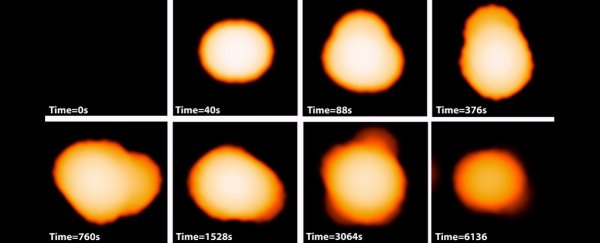On 22 March 2015, NASA's Chandra X-ray observatory recorded a blip in its data. Not far from the southern constellation of Fornax, something brightened, then slowly faded away.
Thanks to a new technique, now we know that blip was two neutron stars colliding, 6.6 billion light-years from Earth.
We also know that when neutron stars collide, they produce two powerful jets, shooting in opposite directions, firing out gamma-ray bursts - but if those jets aren't pointing in our direction, we won't be able to detect them.
But in 2013, astronomer Bing Zhang of the University of Nevada predicted that a neutron star merger could produce a powerful X-ray afterglow if the result of the merger was a highly magnetised, fast-rotating neutron star - a magnetar.
Then, in August 2017, gravitational wave astronomy gave the world a wonder. For the first time, we saw colliding neutron stars in real-time, not just through gravitational wave detectors, but through optical, infrared, ultraviolet and X-ray instruments all around the world.
So, a research team looked through Chandra's archival data looking for events that matched the new information from GW170817 - and found an event that also matched Zhang's predictions.
 (X-ray: NASA/CXC/Uni. of Science and Technology of China/Y. Xue et al; Optical: NASA/STScI)
(X-ray: NASA/CXC/Uni. of Science and Technology of China/Y. Xue et al; Optical: NASA/STScI)
"We've found a completely new way to spot a neutron star merger," said astronomer Yongquan Xue of the University of Science and Technology of China. "The behaviour of this X-ray source matches what one of our team members predicted for these events."
They called the event XT2, and traced it as it suddenly appeared in the data, then slowly faded over the course of about seven hours. They carefully studied how the X-ray emission changed over time, and compared it with Zhang's predictions.
They also considered other possibilities, such as whether the event could have been caused by the core collapse of a dying star. The event's position on the host galaxy's outskirts is more consistent with neutron stars kicked out of the galactic centre, and the low rate of star formation means that the event was less likely to be caused by a young massive star going supernova.
Looking specifically at XT2, the team found that the emission was consistent with a magnetar spinning hundreds of times per second, and with a magnetic field around a quadrillion times stronger than Earth's.
The X-ray emission from the magnetar stayed constant for about 30 minutes, after which it faded by a factor of over 300 over the following 6.5 hours, eventually disappearing. The team believes it was losing energy via an X-ray-emitting wind, which gradually slowed its spin.

This means that the two neutron stars probably produced a larger neutron star, not a black hole. Astronomers think at least three times the mass of the Sun is required to produce a black hole; anything less massive turns into a neutron star. So that places constraints on the size of the neutron stars involved in the collision.
But it also tells us something about the interior of neutron stars, which is incredibly hard to study because of the insane density.
"We can't throw neutron stars together in a lab to see what happens, so we have to wait until the Universe does it for us," Zhang said. "If two neutron stars can collide and a heavy neutron star survives, then this tells us that their structure is relatively stiff and resilient."
The team is now hard at work analysing other Chandra data to, among other things, see if they can start getting some hard statistics on how often events such as these are likely to occur.
"Just as with this source, the data sitting in archives might contain some unexpected treasures," Xuechen Cheng of the University of Science and Technology of China said.
The research has been published in Nature.
